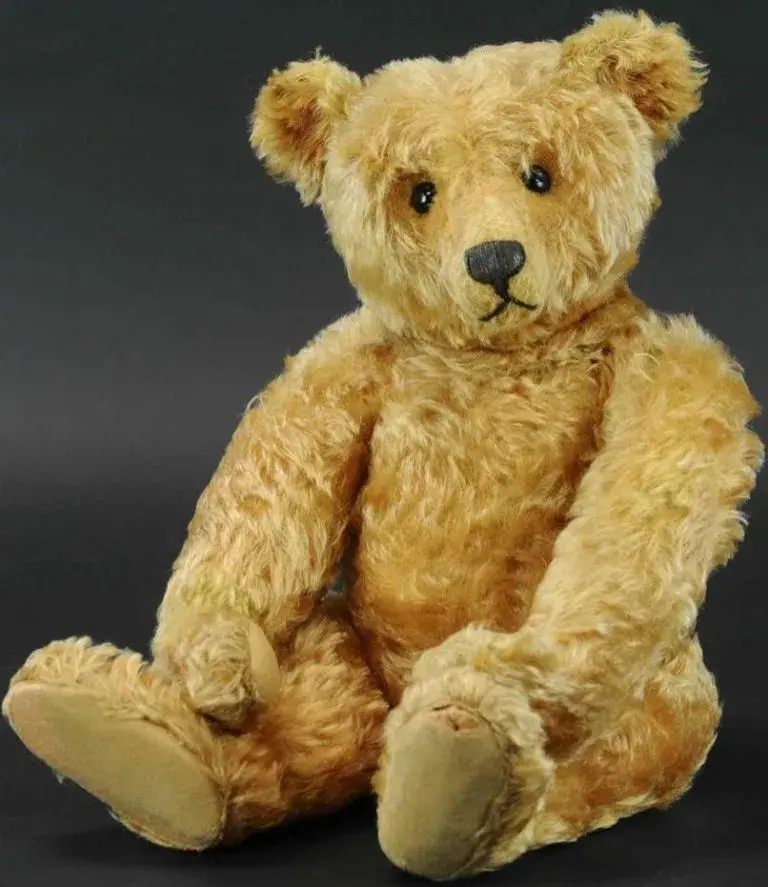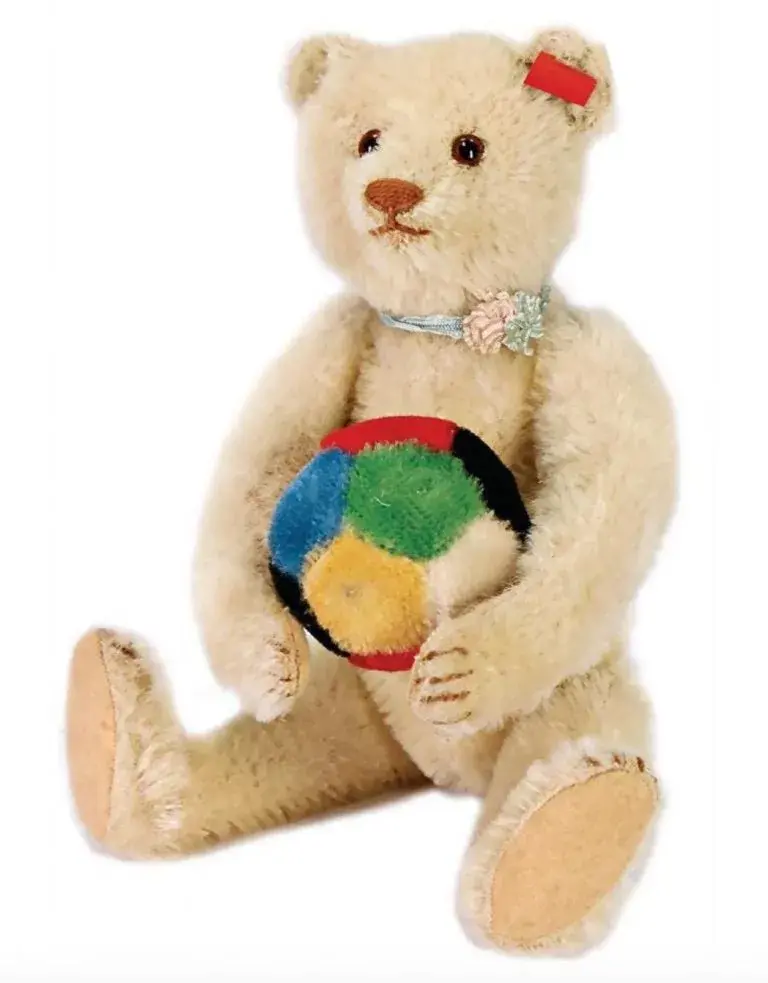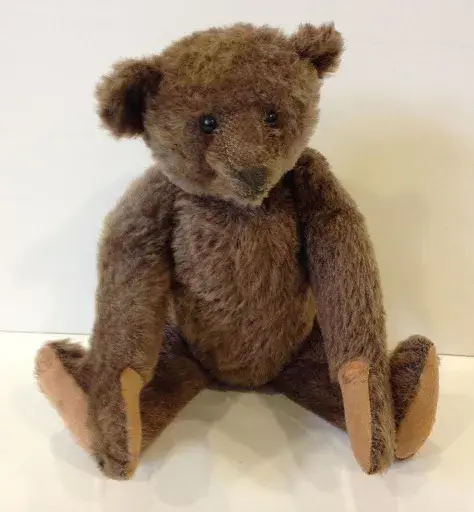4 Trends in Fine Teddy Bear Collecting During Lockdown: Steiff Bears and More

Just over a year ago, lockdowns began in the United States. The auction industry’s online infrastructure largely helped it combat the dearth of live events and the realities of social distancing. Still, each category has performed differently during the pandemic. As a writer for Auction Daily, I follow the antique toy category closely, with a focus on fine Teddy bears and vintage plush. Here are four key trends Auction Daily has noticed about fine teddy bear collecting over the past year.
Trend #1: Fine antique Steiff Teddy bears remain the category’s “gold standard.”
It’s no surprise that fine examples made by the German toy company Margarete Steiff continue to own the Teddy bear category year after year. There is something timeless and appealing about vintage button-in-ear Steiff bears. Those with especially charming presentations, in impressive sizes, and fine condition with IDs can trade hands in the big five-figure range.
Two of the most expensive Steiff Teddy bear vintage auction sales of 2020 took place on November 12th through Bertoia Auctions of Vineland, NJ. The first was lot #482, a 24-inch tall, circa 1905 enter-seam Teddy bear. Estimated at USD 10,000 to $15,000, it realized $25,000. It had 21 bids and 49 watchers. The second was lot #483, a 28-inch tall, circa 1905 “cone-nosed” Teddy bear. Estimated at $10,000 to $15,000, and it realized $22,500. It had 19 bids and 49 watchers.

Although these are just a handful among many sales, they are impressive and suggest that the marketplace is strong and competitive. It also shows that collectors are able and willing to spend top dollar for premier items.
Trend #2: Many collectors are watching, and bidding on, expensive Teddy bears during online auctions.
I’ve noticed that in this specific category, and other related ones, the stay-at-home health crisis has amplified collectors’ interest in things that bring them comfort. Unable to spend on travel, dining, or other diversions, some folks have redirected their funds towards collection building and are willing to pay premium prices for elite temptations.

This was demonstrated well at Appletree Auction Center of Newark, Ohio’s October 2020 event, which featured several appealing Steiff bears that captured the attention and imagination of many collectors. Lot #0368, a 16-inch golden blonde fine Teddy bear from around 1920, realized $4,612.60, with 39 bids and 30 watchers.
This interest isn’t limited to the USA. At Germany’s Ladenburger Spielzeugauktion’s December 2020 sale, lot #5165, a 17-cm white bear from the second quarter of the 20th century, hammered at EUR 6,000 (USD 7,249) and realized EUR 7,440 (USD 8,989) on its EUR 350 to €700 (USD423 – $846) presale estimate. It had an amazing 60 bids and 21 watchers.
Why are Steiff bears so expensive?
Antique Steiff Teddy bears are popular collector’s items, carrying both nostalgia and history. Steiff Teddy bears in particular are highly valued thanks to their multiple styles and varieties. Additionally, Steiff is known for its high-quality designs that can stand the test of time, which means collectors can buy and compete for bears that are over 100 years old. The auction market for Steiff bears has only grown in recent years, raising their value and cost.

Trend #3: Enthusiasts are finding new ways to grow their hugs and create connections and communities.
The uptick in Teddy bear sales and interest over this past year may also be tied to the collecting community’s natural need to feel close to others. This has become exponentially more challenging to do in real life, but online activities help fill the gap. Buying bears at auction is a diversion, an “event” on the calendar to look forward to, and something to talk about on social media.
The number of Teddy bear-related interest groups has skyrocketed on Facebook over the past year, with many conversation threads focusing on auction listings, results, and purchases. Many traditional in-person toy, doll, and Teddy bear gatherings have gone virtual for 2021. I’ve also heard that collectors love the idea that wins are on the way to them post-sale, and a daily visit from the postman (or woman) becomes the highlight of their day until their new bear arrives!

Trend #4: There has been an influx of merchandise across the fine Teddy bear category.
Although it seems counterintuitive at first, I’ve also observed a greater volume of Teddy bear and fine vintage plush available across all marketplaces. Speaking with several collectors looking to rehome items, I am hearing that more people now have some flexibility or time on their hands to tackle projects that have been on the back burner. As such, some folks are going through boxes of inherited or unwanted items given to them and are actively deaccessioning this merchandise through auction or other means.
This downtime also gave enthusiasts more time to refine and evaluate their collections, often resulting in the need to move things along through choice or necessity. And sadly, I hear frequently from collectors who are re-evaluating their priorities because of COVID and are choosing to rehome their collections entirely. For better or worse, this translates into a greater overall supply and the occasional “where has that been hiding for all these years?” auction surprise.
How much are old Steiff bears worth?
Steiff bears regularly sell for thousands of dollars at auction. Factors such as the bear’s age, condition, and style may influence its value. Ready to learn more and take the next step? Check out Auction Daily’s guide to consigning to an auction house.
Rebekah Kaufman is a regular contributor to numerous international print and online publications, lectures across the US and Europe, and provides vintage Steiff consulting and expertise to the media, auction houses, and industry partners. She has no affiliation with Margarete Steiff GmbH or Steiff North America. For more information on vintage Steiff, read Kaufman’s spotlight on Steiff Santa Claus dolls from last year or visit her blog, My Steiff Life.
Find more auction news and a calendar of upcoming events on AuctionDaily.










